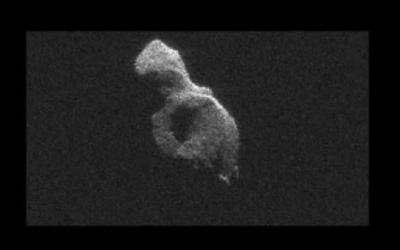Some Of The Most Detailed Images Of Such A Body Ever Captured
NASA scientists using Earth-based radar have produced sharp views of a recently discovered asteroid as it slid silently past our planet. Captured on June 8, 2014, the new views of the object designated “2014 HQ124" are some of the most detailed radar images of a near-Earth asteroid ever obtained.

The radar observations were led by scientists Marina Brozovic and Lance Benner of NASA's Jet Propulsion Laboratory, Pasadena, California. The JPL researchers worked closely with Michael Nolan, Patrick Taylor, Ellen Howell and Alessondra Springmann at Arecibo Observatory in Puerto Rico to plan and execute the observations.
According to Benner, 2014 HQ124 appears to be an elongated, irregular object that is at least 1,200 feet wide on its long axis. "This may be a double object, or 'contact binary,' consisting of two objects that form a single asteroid with a lobed shape," he said. The images reveal a wealth of other features, including a puzzling pointy hill near the object's middle, on top as seen in the images.
The 21 radar images were taken over a span of four-and-a-half hours. During that interval, the asteroid rotated a few degrees per frame, suggesting its rotation period is slightly less than 24 hours.
At its closest approach to Earth on June 8, the asteroid came within 776,000 miles, or slightly more than three times the distance to the moon. Scientists began observations of 2014 HQ124 shortly after the closest approach, when the asteroid was between about 864,000 miles and 902,000 miles from Earth. Each image in the collage and movie represents 10 minutes of data.
The new views show features as small as about 12 feet wide. This is the highest resolution currently possible using scientific radar antennas to produce images. Such sharp views for this asteroid were made possible by linking together two giant radio telescopes to enhance their capabilities.
To obtain the new views, researchers paired the 230-foot Deep Space Network antenna at Goldstone, California, with two other radio telescopes, one at a time. Using this technique, the Goldstone antenna beams a radar signal at an asteroid and the other antenna receives the reflections. The technique dramatically improves the amount of detail that can be seen in radar images.

To image 2014 HQ124, the researchers first paired the large Goldstone antenna with the 1,000-foot (305-meter) Arecibo radio telescope in Puerto Rico. They later paired the large Goldstone dish with a smaller companion, a 112-foot (34-meter) antenna, located about 20 miles away.
A recent equipment upgrade at Arecibo enabled the two facilities to work in tandem to obtain images with this fine level of detail for the first time.
"By itself, the Goldstone antenna can obtain images that show features as small as the width of a traffic lane on the highway," said Benner. "With Arecibo now able to receive our highest-resolution Goldstone signals, we can create a single system that improves the overall quality of the images."
The first five images in the new sequence -- the top row in the collage -- represent the data collected by Arecibo, and are 30 times brighter than what Goldstone can produce observing on its own.
Scientists were fortunate to be able to make these radar observations at all, as this particular asteroid was only recently discovered. NASA's NEOWISE mission, a space telescope adapted for scouting the skies for the infrared light emitted by asteroids and comets, first spotted the space rock on April 23, 2014.
For asteroids, as well as comets, radar is a powerful tool for studying the objects’ size, shape, rotation, surface features and orbits. Radar measurements of asteroid distances and velocities enable researchers to compute orbits much further into the future than if radar observations were not available.
NASA detects, tracks and characterizes asteroids and comets passing close to Earth using both ground- and space-based telescopes. The Near-Earth Object Program, commonly called "Spaceguard," discovers these objects, characterizes a subset of them and identifies their orbits to determine if any could be potentially hazardous to our planet. To date, U.S. assets have discovered more than 98 percent of the known near-Earth objects.
(Images provided by NASA)
 ANN's Daily Aero-Term (04.26.24): DETRESFA (Distress Phrase)
ANN's Daily Aero-Term (04.26.24): DETRESFA (Distress Phrase) ANN's Daily Aero-Linx (04.26.24)
ANN's Daily Aero-Linx (04.26.24) Airborne 04.22.24: Rotor X Worsens, Airport Fees 4 FNB?, USMC Drone Pilot
Airborne 04.22.24: Rotor X Worsens, Airport Fees 4 FNB?, USMC Drone Pilot Airborne 04.24.24: INTEGRAL E, Elixir USA, M700 RVSM
Airborne 04.24.24: INTEGRAL E, Elixir USA, M700 RVSM Airborne-NextGen 04.23.24: UAVOS UVH 170, magni650 Engine, World eVTOL Directory
Airborne-NextGen 04.23.24: UAVOS UVH 170, magni650 Engine, World eVTOL Directory




